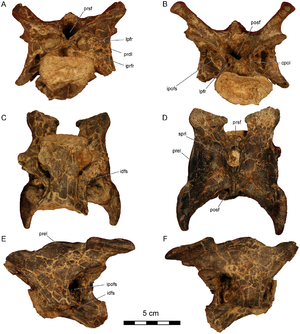Dahalokely
| Dahalokely | ||||||||||
|---|---|---|---|---|---|---|---|---|---|---|

Fossilized cervical vertebrae from the holotype of Dahalokely tokana |
||||||||||
| Temporal occurrence | ||||||||||
| Upper Cretaceous ( Turonium ) | ||||||||||
| approx. 92.19 to 91.4 million years | ||||||||||
| Locations | ||||||||||
| Systematics | ||||||||||
|
||||||||||
| Scientific name | ||||||||||
| Dahalokely | ||||||||||
| Farke & Sertich , 2013 | ||||||||||
| Art | ||||||||||
|
||||||||||
Dahalokely is an extinct genus of theropod dinosaur . Their relatives livedon Indo-Madagascar during the late Cretaceous period and were probably around 3.5 to 5.5 m long. Their fossil remains were in the 2007 Malagasy Ambolafotsy formation found and 2013 by Andrew Farke and Joseph Sertich as a new genus and species - dahalokely tokana - described . On the basis of their osteological characteristics, the two authors classified Dahalokely as an original representative of the Noasauridae . The animals' habitat wascloseto the coast and their systematic position suggests a carnivorous diet.
features
The existing fossil material from Dahalokely includes remnants of the spine and also a rib of the presumably second pair of ribs of the spinal column . The cervical vertebrae are distinguished from those of other Abelis auroids mainly by their small size. A unique feature of Dahalokely is the construction of the prezygapophyseal lamina - a pair of thin bone ridges that connect the prezygapophyses on the front and the epipophyses on the back of the cervical vertebra. These bone ridges are clearly arched at their center and separated from the epipophyses on both sides by small bumps. The vortices of the genus are comparatively small for Abelis auroids. Based on their dimensions and the proportions known from other genera, a total length of 3.5-5.6 m is assumed for Dahalokely .
Stratigraphy, diffusion, and fossil material
All of Dahalokely's fossils were found in 2007 in the middle Ambolafotsy formation in the far north of Madagascar . These are vertebrae from the neck and anterior back and two ribs from the anterior chest. The lower part of the Ambolafoty formation can be determined based on the Foraminifere Helvetoglobotruncana helvetica at an age of 93.52–92.99 mya . The ammonite species Subprionocyclus neptuni , which appeared for the first time in 90.86 mya, occurs above the find layer . Despite the lack of key fossils in the actual find layer of Dahalokely , the age of the fossils can thus be limited to the outgoing sub-turonian and the early upper-turonian (about 93.52–89.77 mya).
Taxonomy and systematics
The material recovered in 2007 from the Ambolafotsy formation ( inventory number UA 9855) was first prepared by Joseph Groenke at Stony Brook University and then analyzed by Andrew Farke and Joseph Sertich and compared with that of other Abelis auroids . Farke and Sertich ultimately designated it as the holotype of a new species and genus, Dahalokely tokana . The generic name ( Malagasy dahalo for "bandit", kely for "small") refers to the relatively small size for Abelis auroids , the specific epithet tokana means something like "lonely" in Malagasy. He refers to the spatially and temporally isolated location of the species, whose members were the only known representatives of the Abelisaouroidea on Indo-Madagascar after it broke away from Gondwana and before it split into India and Madagascar .
Statistical comparisons of the fine osteological features by Farke and Sertich showed Dahalokely to be an original clade of the Noasauridae , but showed only weak bootstrap support for this classification. The authors therefore considered the location of the genus in the Noasauridae as provisional. Although Dahalokely is the only known abelosauroid of Madagascar from the Turonian, the analysis assigns the Malagasy taxa Majungasaurus and Masiakasaurus from the Cretaceous to different families, so that during Dahalokely's lifetime the ghost lineage of Majungasaurus was possibly also represented in the region.
swell
literature
- Andrew A. Farke, Joseph JW Sertich: An Abelisauroid Theropod Dinosaur from the Turonian of Madagascar. In: PLoS ONE . Vol. 8, No. 4, 2013, e62047, doi : 10.1371 / journal.pone.0062047 .
